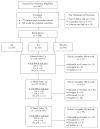Social cognitive changes following weight loss and physical activity interventions in obese, older adults in poor cardiovascular health
- PMID: 22773225
- PMCID: PMC3593110
- DOI: 10.1007/s12160-012-9390-5
Social cognitive changes following weight loss and physical activity interventions in obese, older adults in poor cardiovascular health
Abstract
Background: The study objectives were to determine (a) the effects of group-mediated cognitive-behavioral interventions on change in performance self-efficacy, satisfaction with function, and with appearance among older, overweight/obese adults in poor cardiovascular health and (b) whether self-efficacy mediated change in 400-m walk time.
Methods: This translational, randomized controlled trial of physical activity and weight loss was conducted within community Cooperative Extension Centers. Participants were randomized to three intervention arms: Physical Activity, Weight Loss + Physical Activity, or a Successful Aging education control.
Results: Across 18 months, the Weight Loss + Physical Activity intervention demonstrated greater improvements in self-efficacy, satisfaction with function, and appearance versus other trial arms. Physical Activity intervention participants also experienced significant improvements in self-efficacy and satisfaction with function versus those in Successful Aging. Self-efficacy mediated 400-m walk time at 18 months.
Conclusions: Both group-mediated cognitive-behavioral interventions yielded desirable improvements in social cognitions and preserved mobility improvements post-intervention.
Trial registration: ClinicalTrials.gov NCT00119795.
Conflict of interest statement
Figures
Similar articles
-
Change in health-related quality of life and social cognitive outcomes in obese, older adults in a randomized controlled weight loss trial: Does physical activity behavior matter?J Behav Med. 2018 Jun;41(3):299-308. doi: 10.1007/s10865-017-9903-6. Epub 2017 Nov 22. J Behav Med. 2018. PMID: 29168052 Free PMC article. Clinical Trial.
-
Impact of a male-only weight loss maintenance programme on social-cognitive determinants of physical activity and healthy eating: A randomized controlled trial.Br J Health Psychol. 2015 Nov;20(4):724-44. doi: 10.1111/bjhp.12137. Epub 2015 Mar 16. Br J Health Psychol. 2015. PMID: 25777588 Clinical Trial.
-
The effect of weight management interventions that include a diet component on weight-related outcomes in pregnant and postpartum women: a systematic review protocol.JBI Database System Rev Implement Rep. 2015 Jan;13(1):88-98. doi: 10.11124/jbisrir-2015-1812. JBI Database System Rev Implement Rep. 2015. PMID: 26447010
-
Relations of changes in self-regulatory efficacy and physical self-concept with improvements in body satisfaction in obese women initiating exercise with cognitive-behavioral support.Body Image. 2010 Sep;7(4):356-9. doi: 10.1016/j.bodyim.2010.05.001. Epub 2010 Jun 11. Body Image. 2010. PMID: 20541986 Clinical Trial.
-
Exercise, self-efficacy, and mobility performance in overweight and obese older adults with knee osteoarthritis.Arthritis Rheum. 2005 Oct 15;53(5):659-65. doi: 10.1002/art.21466. Arthritis Rheum. 2005. PMID: 16208674 Clinical Trial.
Cited by
-
Effects of a Group-Mediated Exercise and Dietary Intervention in the Treatment of Prostate Cancer Patients Undergoing Androgen Deprivation Therapy: Results From the IDEA-P Trial.Ann Behav Med. 2018 Apr 19;52(5):412-428. doi: 10.1093/abm/kax002. Ann Behav Med. 2018. PMID: 29684136 Free PMC article. Clinical Trial.
-
Health-related social control in overweight romantic couples: daily associations with physical activity and affect for targets and agents.Ann Behav Med. 2025 Jan 4;59(1):kaae093. doi: 10.1093/abm/kaae093. Ann Behav Med. 2025. PMID: 39774604 Free PMC article. Clinical Trial.
-
The MAT-sf: identifying risk for major mobility disability.J Gerontol A Biol Sci Med Sci. 2015 May;70(5):641-6. doi: 10.1093/gerona/glv003. Epub 2015 Feb 13. J Gerontol A Biol Sci Med Sci. 2015. PMID: 25680917 Free PMC article.
-
Change in health-related quality of life and social cognitive outcomes in obese, older adults in a randomized controlled weight loss trial: Does physical activity behavior matter?J Behav Med. 2018 Jun;41(3):299-308. doi: 10.1007/s10865-017-9903-6. Epub 2017 Nov 22. J Behav Med. 2018. PMID: 29168052 Free PMC article. Clinical Trial.
-
Understanding Weight Loss via Online Discussions: Content Analysis of Reddit Posts Using Topic Modeling and Word Clustering Techniques.J Med Internet Res. 2020 Jun 8;22(6):e13745. doi: 10.2196/13745. J Med Internet Res. 2020. PMID: 32510460 Free PMC article.
References
-
- McNeill AM, Katz R, Girman CJ, et al. Metabolic syndrome and cardiovascular disease in older people: The Cardiovascular Health Study. J Am Geriatr Soc. 2006;54:1317–1324. - PubMed
-
- Ettinger WH, Jr, Fried LP, Harris T, Shemanski L, Schulz R, Robbins J. Self-reported causes of physical disability in older people: The Cardiovascular Health Study. CHS Collaborative Research Group [see comments] J Am Geriatr Soc. 1994;42:1035–1044. - PubMed
-
- Guralnik JM, LaCroix AZ, Abbott RD, et al. Maintaining mobility in late-life. 1. Demographic characteristics and chronic conditions. Am J Epi. 1993;137:845–857. - PubMed
-
- Hirvensalo M, Rantanen T, Heikkinen E. Mobility difficulties and physical activity as predictors of mortality and loss of independence in the community-living older population. J Am Geriatr Soc. 2000;48:493–498. - PubMed


